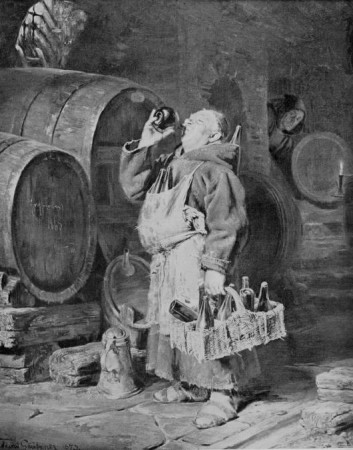
A large Bohemian copper serving stein on the floor. See more at this page: “The Sport of Drinking; the Monks” = http://www.steveonsteins.com/the-sport-of-drinking-p3-the-monks-11-1-10-no-x
[Editor’s note 6-1-2013l Anyone interested in Copper, or old mining should enjoy reading this article ~ I did!
http://www.rawstory.com/rs/2013/06/01/mes-aynak-afghanistans-buddhist-buried-treasure-faces-destruction/
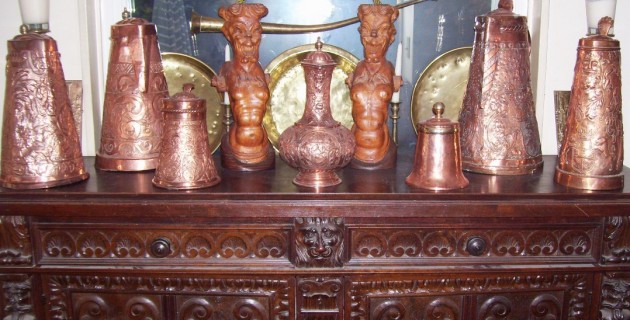
Shown ▲: About 1/5th of the copper beer steins in the Smith’s Museum and Tavern Collection “From Which to Drink ” These are all Bohemian and mostly large engraved serving steins. The carved wooden torsos shown are from large piece of ‘Neauveao-Renaissance’ furniture, or perhaps supporters for a very large staircase’ handrail.
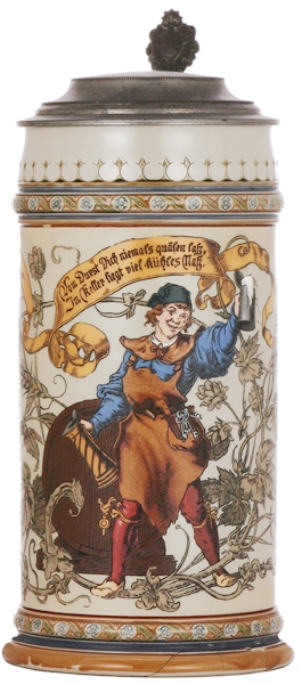
A copper serving stein shown being used on a V & B Mettlach stein, No. 1941. This appears to be a “Bavarian style” with twisted body (just the engraved design), which would make sense as Mettlach town was a lot closer to Bavarian than to Bohemia. [TSACO]
10-25-10.
I recently got an email from a stein collector / seller that asked a question that pertained to this subject of this page. So I thought I’d just duplicate the question -in blue and italics! And my response here, thereby giving the reader access to the reason why this page even exists!
“Now I have another question – you have divided all early copper in “Bavarian” and “Bohemian” categories.
However, [J] Vogt in his catalogs quite often calls “Nuernberg” the very same pieces you describe as Bohemian. From studying [J] Vogt catalogs I came to the conclusion that Nuernberg was a major supplier of copper ware. But somehow it is missing from your classification. What do you think of Nuernberg in term of copper ware production? Regards
Now taking one part of this question at a time:
[YOUR] “Now I have another question – you have divided all early copper in “Bavarian” and “Bohemian” categories.” All? Not so! The intent of the (this web) page was just to define the difference between only those two centers of copperware production. This discussion was started years ago at a “Beer Stein College” exactly because of the reasons behind your question; that is: J. Vogt was incorrect (on purpose, or ignorant, or both) and I wanted to set the stein record straight.
Taking one part of the question at a time:
“However, [J] Vogt in his catalogs [ see below] quite often calls “Nuernberg” the very same pieces you describe as Bohemian. From studying [J] Vogt catalogs I came to the conclusion that Nuernberg was a major supplier of copper ware. But somehow it is missing from your classification. What do you think of Nuernberg in term of copper ware production? Regards,
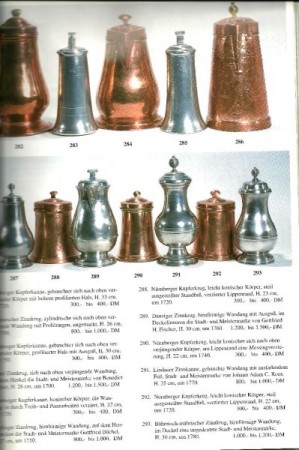
Photo above : Taken from a J. Vogt auction.
That is a good question! .I will include this answer on the S/O/S webpage! [1] Vogt was a business man = Which sounds better to “German” stein collectors: “Nurnberg or Bohemian?
Hardly anyone today knows where in the hell Bohemia was, or when! If you asked 1,000 Americans where “Nurnberg” was located I think you might get 20 to 25 correct answers. Asked to pin point its general vicinity on a map, maybe 10 to 15 could do it. But, I serious doubt two persons in 1,000 would know “Bohemia;” and none could pin point it on a map. I doubt that the percentages in Europe would be very much higher (given the responses by young adults here in The United States to Jay Leno’s very easy history and geography questions; as on “Jaywalking”.)
Paris is in London ?? !! = http://www.youtube.com/watch?v=2FqNfPQJQ8c&feature=related [or] http://www.youtube.com/watch?v=01YhjP2t1os
So J. Vogt [a well known German stein auctioneer= RIP] called them ‘Nurnburg’ and [1] no one ever “called him” on it, and [2] he never really said they were “made there”, he just inferred it. Also [2[ as the center point of Bohemia was only about 200 km from the old Bavarian border, I am certain some Bohemian copper pieces were sold there within that city (it was a huge European trade center) or migrated with the people when they moved closer to a big city from the hinterlands.
![COPPER, ANTIQUE - FROM BOOK [BEST]](http://www.steveonsteins.com/wp-content/uploads/2010/05/COPPER-ANTIQUE-FROM-BOOK-BEST--450x316.jpg)
[2] The book “The Pictorial Encyclopedia of Antiques” (The Hamlyn Publishing group – 1970) is an excellent reference on these Bohemian copper vessels and show a few examples of the handle construction that they are noted for. It was the defining reference for me early on. Interestingly, as pertains to this subject, I quote from that book’s section on “Copper,” Page 400: “In the 17th and 18th centuries when a wide range of household utensils was in use, two new factors began to affect the design of copper ware; the different districts [metal working centers] wanted to give their wares an individual regional stamp, and at the same time copper-smiths were attempting to produce articles which would closely resemble pieces made in other metals and yet retain their individually. So it is not surprising to find one particular type of design a special shape of handle or spout, or an unusual lid, cropping up in various places [metal working centers] .”
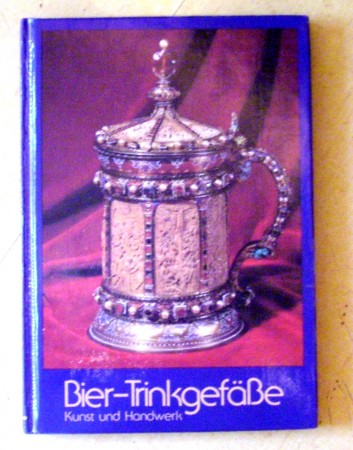
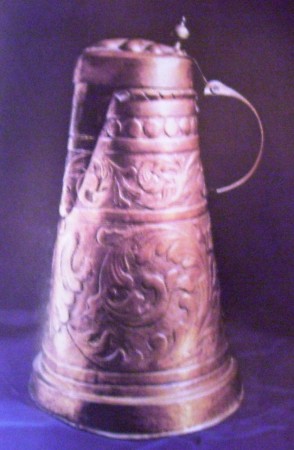
[3] The book, “Bier –TrinkgefäBe- Kunst and Handwerk” [produced by “Rastal in 1978”]; on page 54 shows an example of those large copper serving steins (with that same handle, lid and hinge assembly that J. Vogt called ‘Nurnberg’) and the book labels the stein as from “The Guild of the Prague Maltsters – 1747.” Prague was in the center of Old Bohemia – now the Czech Republic.
It is highly doubtful in my mind that, those Guild Masters would have ordered one of these steins to be made not even close to Prague, but in another country no less!
Other ‘stein selling web sites’ are just as bad! or worse!! A few years back there was a stein advertised as having a student society’s “crest.” I told the web-dealer it was nothing but the city arms of Hamburg and had nothing to due with students. He refused to change the listing – even after I sent him an email of the whole background on the city’s arms as defined on HERALDRY OF THE WORLD = http://www.ngw.nl/
![SOS - COPPER EVEN THE DAMN MUNICH MUSEUM HAS THIS ONE WRONG [1]](http://www.steveonsteins.com/wp-content/uploads/2010/05/SOS-COPPER-EVEN-THE-DAMN-MUNICH-MUSEUM-HAS-THIS-ONE-WRONG-1-474x630.jpg)
![SOS - COPPER EVEN THE DAMN MUNICH MUSEUM HAS THIS ONE WRONG [2]](http://www.steveonsteins.com/wp-content/uploads/2013/08/SOS-COPPER-EVEN-THE-DAMN-MUNICH-MUSEUM-HAS-THIS-ONE-WRONG-2-414x630.jpg)
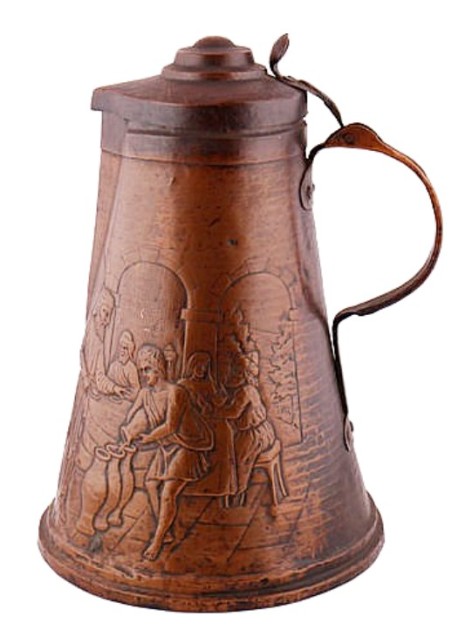
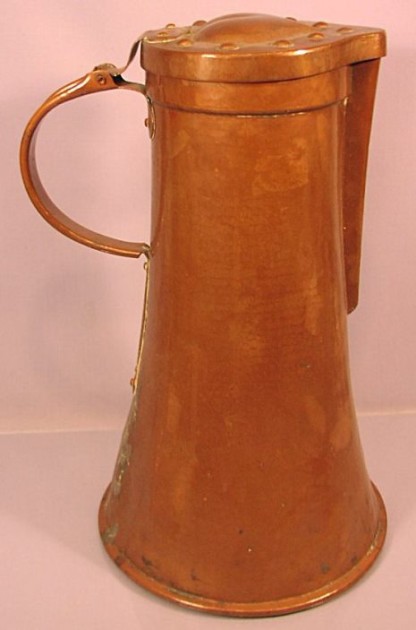
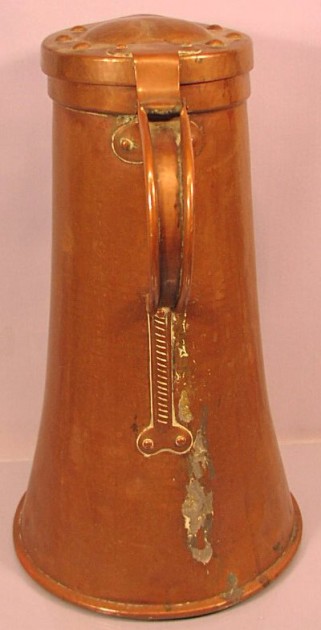
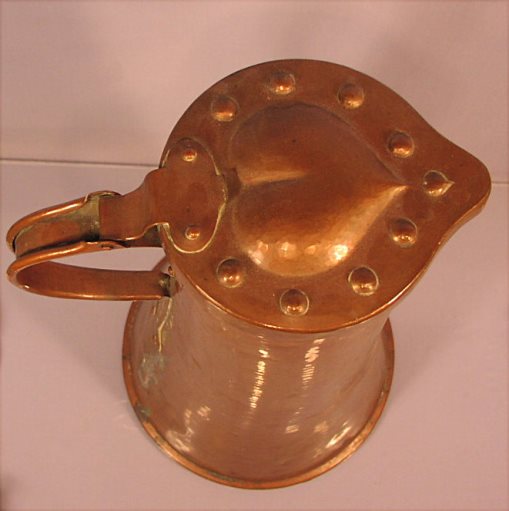
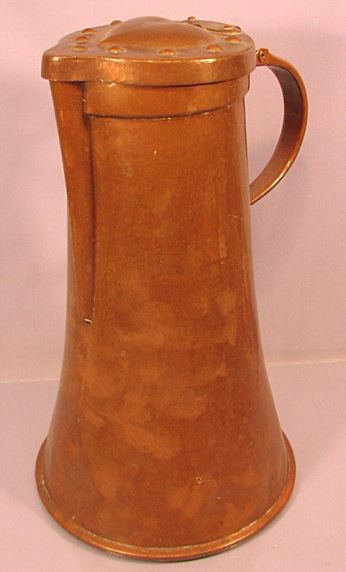
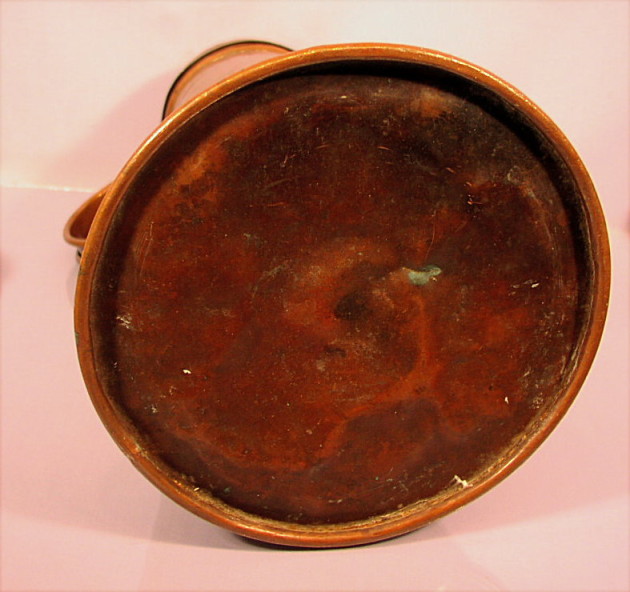
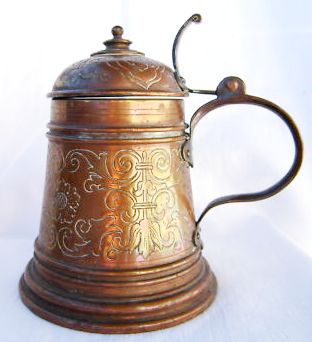
What struck me right away was that the body and then the handle shape appeared “at first brush” to be a Bohemian piece. So I blew up the photos and noticed right away that there were several differences apparent to my eye! So I will now compare the two, using photo versus photo.
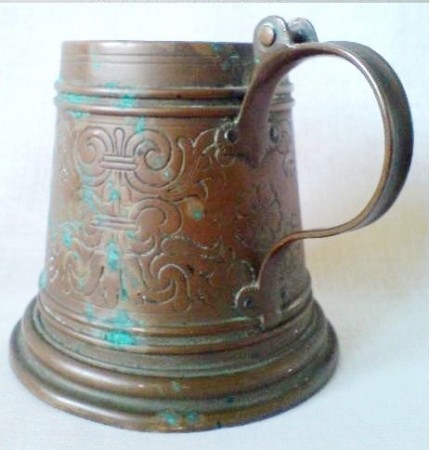
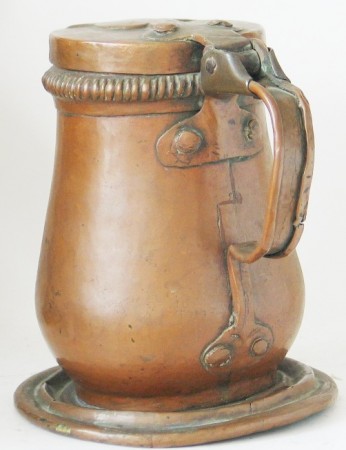
[L] BAVARIAN [R] BOHEMIAN
[Right] A very old Bohemian copper stein. This one shows the rolled over handle sides, [FWTD] the rolled over base (for more support – probably used for heavy bar drinking.) The plain flat round shaped thumblift is missing, and this one has a very unusual brass support at the hinge. Circa mid to late 1600′ s.
The handle of the ‘Bavarian’ stein in question has no rolled over sides for added strength as one can see here on the ‘Bohemian’ stein above.
t not all ‘Bohemian’ steins have this rolled over handle edge! They stoped making them that way it sometime in the mid 1800’s I think. .
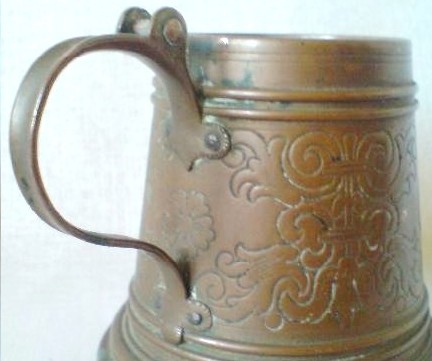
“Tri-foil cut” (engraved sometimes) handle attachments = Bavarian. Most often found on steins made and stamped in Munich, see maker’s stamp just below.
[2] While the Bavarian’s handle shape looks fairly close to the “?” mark form, the end of handle does not come really close to the body, and these handle attachments have a specific cut and engraved design; which I will call “The tri-foil cut” (for the lack of a better term.) The older Bohemian steins did not have this; all the attachment edges were rounded with no “touch up” engraving, and also do not have that small point on the bottom.
[3] The wear (indicating) age of this newly shown Bavarian piece is significantly younger than comparable styled Bohemian pieces that I have seen.
.
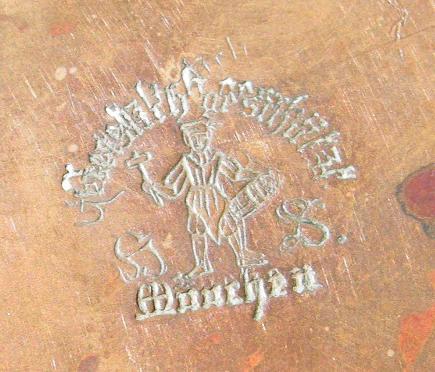
[4] It carried a stamped maker’s mark, from Munich, (SJ & SG). I have yet (even up to the end of 2015) to see a very old Bohemian stein that was marked.
Now having reviewed all the aspects of this stein, and the fact that there were a few Bohemian pieces that were made with flat handles.
……………… ………
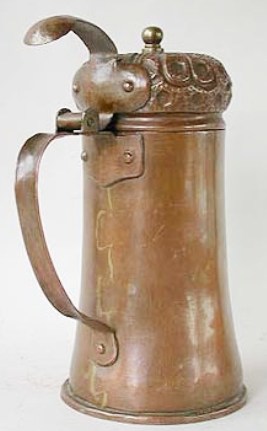
………………….
I can now see where Mr. J. Vogt might have gotten support for his idea that these slanted side & large base forms came from Bavaria and not Bohemia.
Here is another “cross over stein” = what appears to be a Bohemian produced copper stein, (by its thumblift and handle) it has an inscription on it to a Bavarian military unit stationed close to Munich. There was obviously a fairly big market for these Bohemian copper steins in Bavaria.
BOHEMIAN BELOW:
.
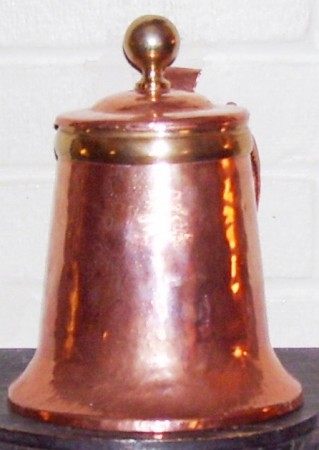
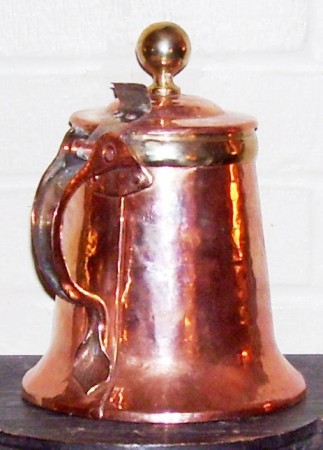
A relatively plain Bohemian piece, Circa 1830-60, with the typical bent up (but not rolled over) sides on the “?” mark handle but with a unique spade shaped finial at the bottom of the handle. [FWTD] Brass ball finial and rim around the top. Hard to find.
.
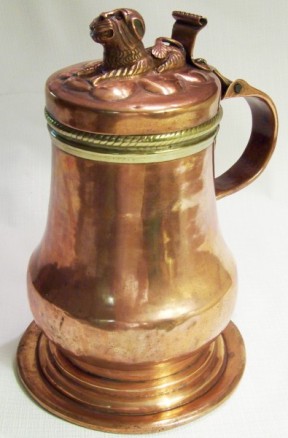
This stein, about 7 inches tall, also has a thick rolled over base rim to give it additional strength (as does the Bohemian example up above.) This is not normally found on later Bohemian copper steins, say from the early part to the middle of the 1770’s. The medieval style lion’s head was punched out of the flat copper sheet on a mold, then finished off by hand soldering . The brass neck band was also soldered to the body. About 7 inches tall. Mid to late 1600’s. Very scarce! This little jewel was mine and I sold it!
Can you spell: S-t-u-p-i-d !
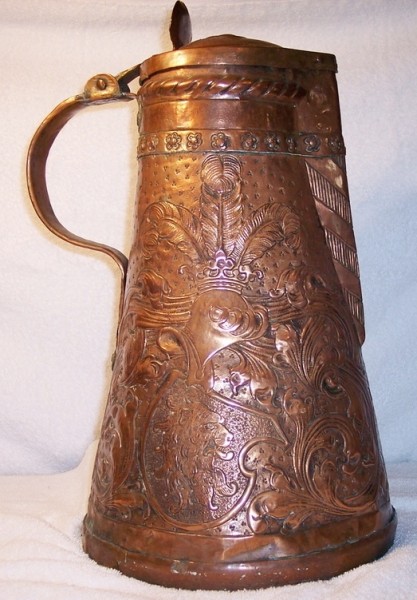
A Bohemian armorial copper serving or master stein with an applied spout. It is easily engraved and repousséd. It has a flat oval thumblift and handle sides which were turned over, with a flat section in the middle to the top. At also comes with repousséd “twisted cord” design on top of the body The bottom of the base has been rolled over and soldered to the body. This serving stein is about 15 inches tall. Circa: late 1600s – early 1700′ s[FWTD]
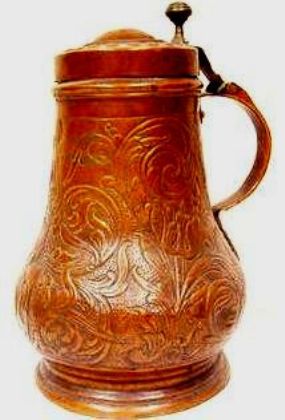
Another with rolled over handle sides. On this on the ripped band was punched out of the body’s neck and not applied. The handle’s end being elongated and coming further down the body of Bohemian pieces (looking like a question mark) is another sure sign of Bohemian origin, as is the lid to handle hinge arrangement. Stein is about 13 inches tall. Circa early 1700’s.
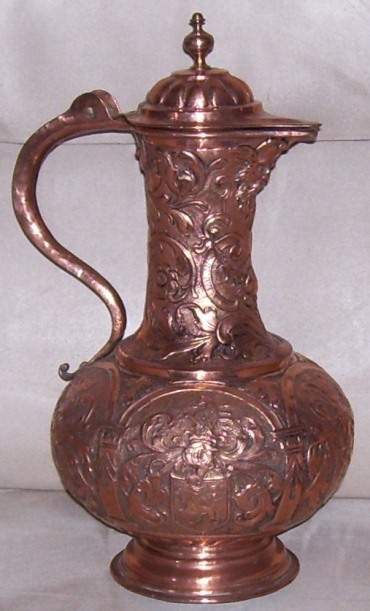
A smaller wine server with armorials, with two armorials engraved on the front, probably a wedding present. [FWTD] Twisted handle, and a brass finial Bottom of base rolled over for strength. Stein is about 14 inches tall. Circa early 1700’s. [FWTD] [See group photo below]
A Bohemian “Beer Mug”, late 1600’s – early 1700’s. The armorial engraving and repoussé work on these early pieces is outstanding. That workmanship is as good as any master silver-smith’s work, but the vessels were about 50% cheaper back then.
Blown up so the reader can see all the hand stipling (small punched dot work) on the surface around the larger features. The arms / helm’s mantling must have taken some time to do also! [FWTD]
![BOHEMIAN - STEIN $339 total - dated 1623 [q] 11-27-09 called Italian - RIPPLED RIDGE PUNCHED OUT AND NOT APPLIED SEPARATELY](http://www.steveonsteins.com/wp-content/uploads/2010/05/BOHEMIAN-STEIN-339-total-dated-1623-q-11-27-09-called-Italian-RIPPLED-RIDGE-PUCNHED-OUT-AND-NOT-APPLIED-SEPARTLY--349x450.jpg)
Bohemian stein, this one is recently been heavily polished, but please see the way the handle is constructed with rolled over sides, on top of the handle, a tell tale sign of Bohemian manufacture (sans thumblift – which seems to be a common occurrence.) Ca. mid to late 1700’s. (Note the relief band around the top of the body.)_
Another example of outstanding metal work showing the Imperial (Holy Roman Empire) double headed eagle. Ca. late 1600’s to early 1700’s. [FWTD]
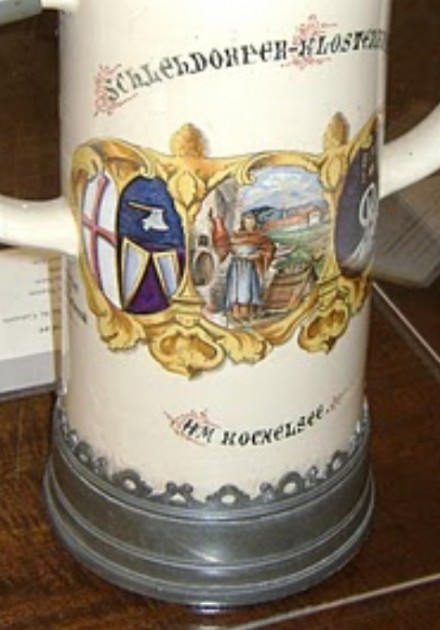
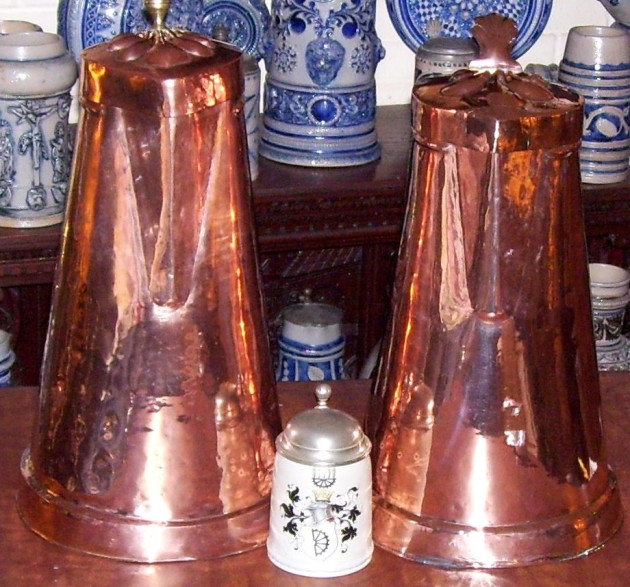
These two are plain but large! These are the kind depicted on the brewery beer stein just above ▲. Made for use not decoration. Both Ca, late 1600- early 1700’s. While I have had the server to the right for some time now, I just picked up another just a bit taller and it has a different lid design and thumblift. The .5 liter V&B Mettlach No. 1526 with the hand painted Cost of Arms [family] is just for size comparison.
[Ex-FWTD] 12 -2014]
Shown again! The landing display at “S.M.& T.” of Bohemian made Copper Steins (and a buch of old dreck), a few months later than this page’s opening photo. The servers are all very large and most from the very late 1600’s – mid 1700’s.
Blow up to note the differences of the base rim and lid designs.
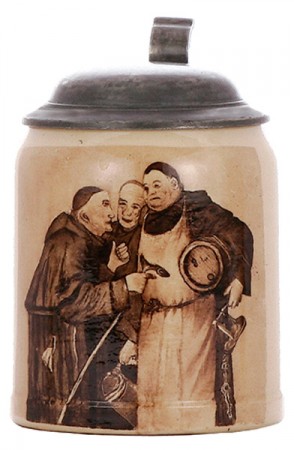
An interesting .5 liter, circa 1900. pottery stein, probably made in Austria showing monks, one who is carrying the traditional copper beer server. [tsaco]
BAVARIAN COPPER STEINS ARE NOW SHOWN BELOW▼▼:
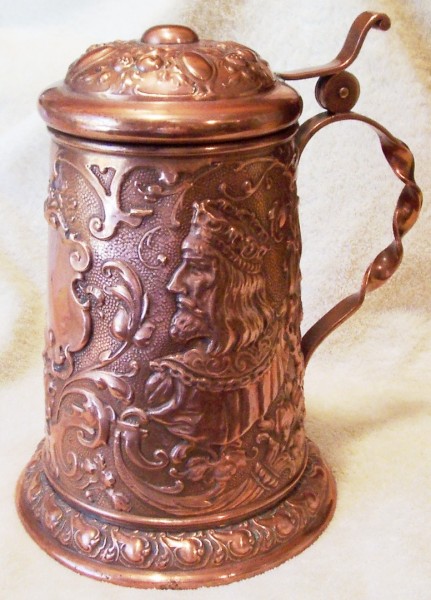
Flat ribbon thumblifts attached straight to the lid, and thin twisted handles are most often found on Bavarian made (Nurnberg and Munich) copper steins. [X-FWTD] The scene is a relief of Emperor Maximillian. Emperor Rudolf is on the reverse.
All the steins shown below ▼down to the double red line are all “stamped” or “pressed” sheet copper work.
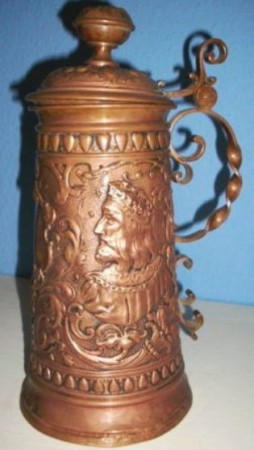
Same relief design on a larger body, with large ball type finial added and lots more of a twisted handle
There is yet a third version, this one sitting on a pedestal base such as shown in Ill. AA below.
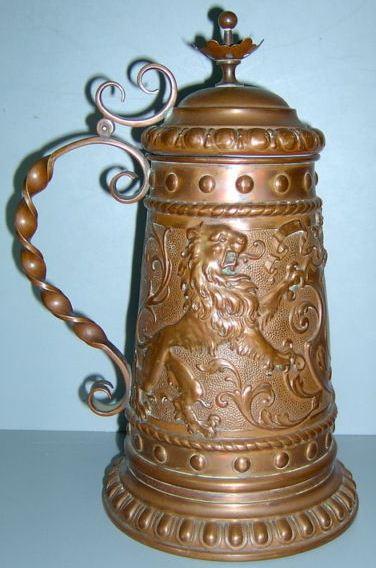
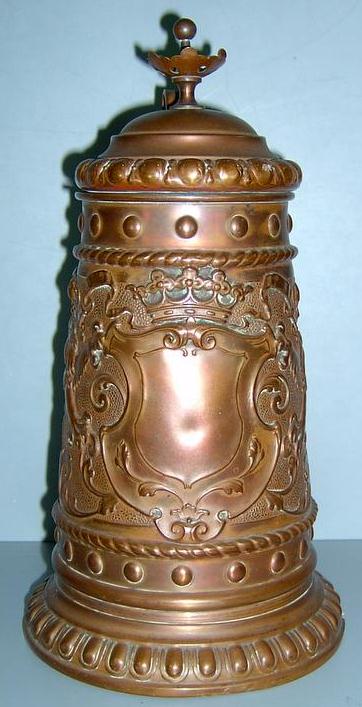
Above 2 photos and one below: Yet another example of this firms workmanship. Shown here as the finial is quite different and the insides show the tin lining with very little use. Nice looking piece even with a few minor dents. (Easily fixed with two “Smith stein tools.”)
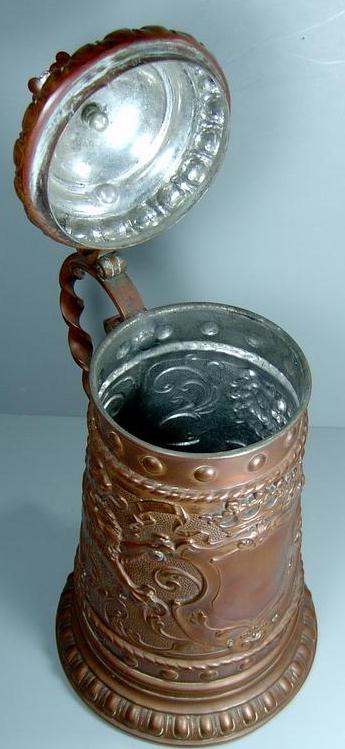
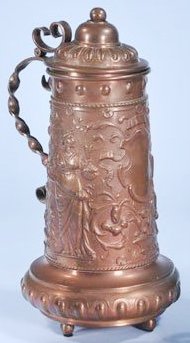
Ill. AA 14 inch tall server made by the same company. The added base with the feet makes it look like a much larger capacity than it is. [FWTD]
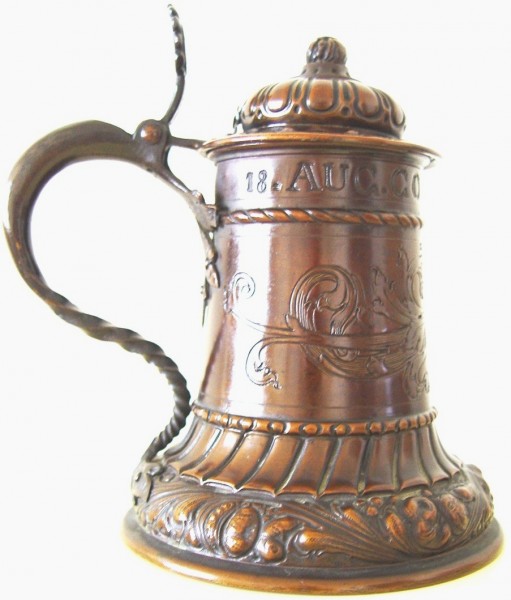
Here is a stein that has the twisted handle but it also is applied in the typical question mark style of the Bohemians, with an extra long section at the bottom. But this one is not ‘all’ attached to the body as the Bohemian ones are. The relief work around the base and on the top make it a definite Bavarian (Nurnberg / Munich) copper stein. Hard to see in this photo is another Bavarian indicator; tooled ends (they appear as leaves) to the upper and lower handle–to-body attachments. I believe this to be made by (SJ & SG) Munich, .
Another typical late 19th century Bavarian stein with a flat twisted handle (an added little touch are the cut ends) with nice but not too elaborate relief work.
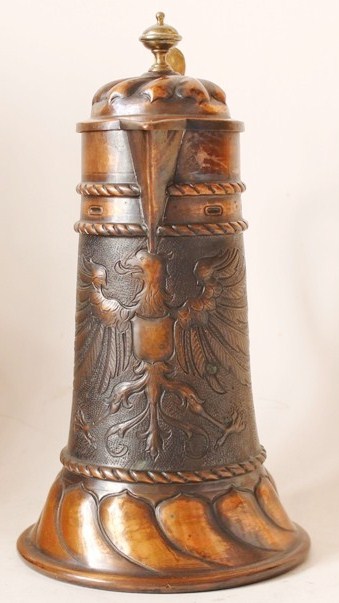
While the handle is not showing on this photo, it is obvious to me that this stein, Ca. late 19th century.and the one above ▲were made by the same firm, most probably (SJ & SG) Munich.
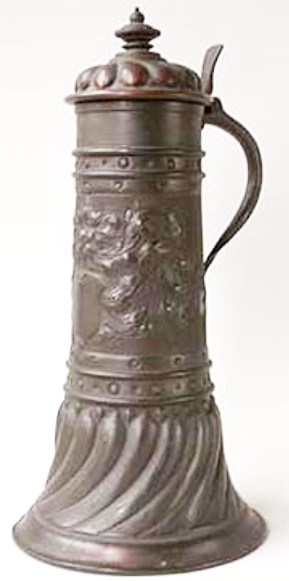
An example of [1] the typical Bavarian stein with no other decoration on it [2] how oxidized one can find these beer steins:
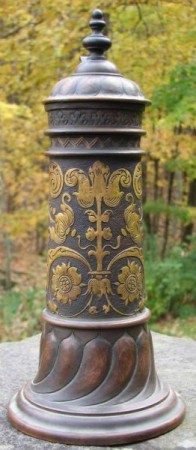
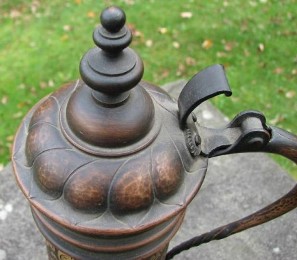
[L] This photo clearly indicates another Nurnberg / Munich touch, that of gold plating part of the stein’s surface for added effect. [R] Detail of repossed lid from the above stein, and the twisted handle attachment to it. It also has the typical “shoe horn” thumblift found on most Nurnberg / Munich copper beer steins.
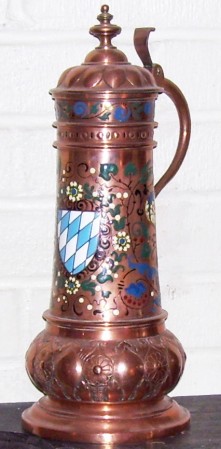
Copper serving stein with cloisonné, this piece was made by the same firm as the stein just above. Barbarian (probably Munich). The shield is from The Wittlebach’s family, the old ruling family of Bavaria. [FWTD]
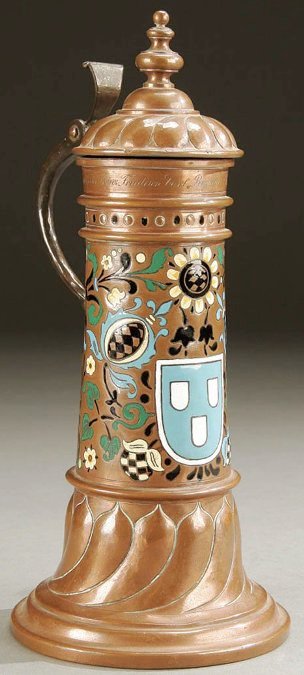
And another, with enameled Coat of Arms for a painter.
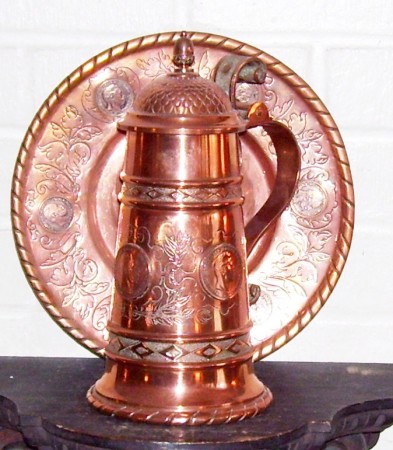
A half liter copper stein, with three mounted copper plated coins of the Three Kaisers of 1888, and its matching tray. [FWTD] While the hinge assembly is reminiscent of Bohemian work, it is very doubtful that this was made anywhere else but in Germany. The handle has “stipple work” all over it, as shown around the diamonds on the two body bands.
For more info on the Year of the three Kaisers of 1888, See: “1888 – The year of the three German Kaisers” in this site’s Compendium.
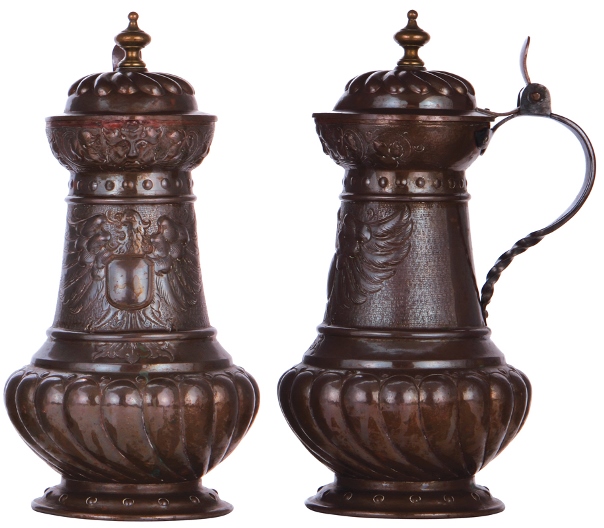
this 14 inch Bavarian copper beauty sold cheap at a USA auction in 2013; mostly because I didn’t send myself a reminder when the auction date was
[END- SOK – 50 [+8 ▼] – 4D]
 “Bad decisions make good stories.”
“Bad decisions make good stories.”
ADDITIONAL BOHEMIAN COPPER VESSELS
![SOS - BOH -[1] $666.00 12-30-12 - ALT](http://www.steveonsteins.com/wp-content/uploads/2010/05/SOS-BOH-1-666.00-12-30-12-ALT.jpg)
![SOS - BOH [3] - $666.00 11-30-12 - c](http://www.steveonsteins.com/wp-content/uploads/2010/05/SOS-BOH-3-666.00-11-30-12-c.jpg)
A wonderful rendition of a cross between a Bellarmine face and a wild man or Bartmann;s face as a spout.
![SOS - BOH - [2]$666.00 11-30-12 - b](http://www.steveonsteins.com/wp-content/uploads/2010/05/SOS-BOH-2666.00-11-30-12-b-458x630.jpg)
![SOS - BOH -[4] $666.00 11-30-12COPPER SERVING STEIN - f](http://www.steveonsteins.com/wp-content/uploads/2010/05/SOS-BOH-4-666.00-11-30-12COPPER-SERVING-STEIN-f-413x630.jpg)
This beautiful Bohemian copper server did not end up in the “From which To Drink” Collection. It was offered for sale right after I had just been cleared of having throat cancer but I developed a case of shingles at the radiation’s on point of entry on my neck , and I wasn’t feeling much like doing anything .let alone spending well over a half of a K and adding to the collection about then.
Now I’m thinking that was a damn shame I felt that way!
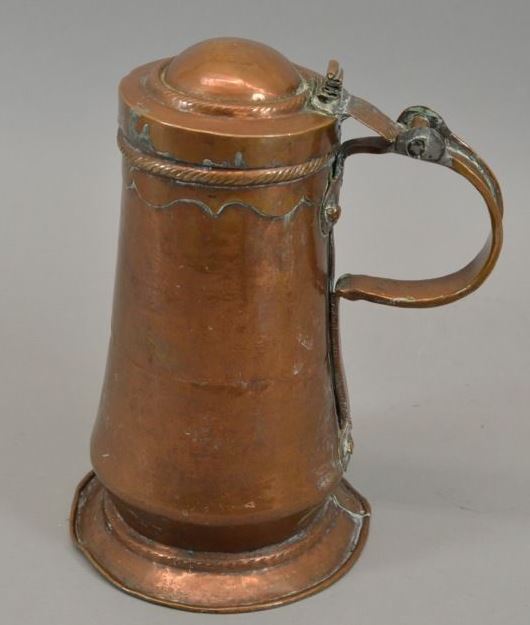
Bohemian copper on ebay twisted, smashed down thumblift; lots of these 1600-1700’s stein s have a problem at the thumblift to lid junction. 10.3 inches tall
.
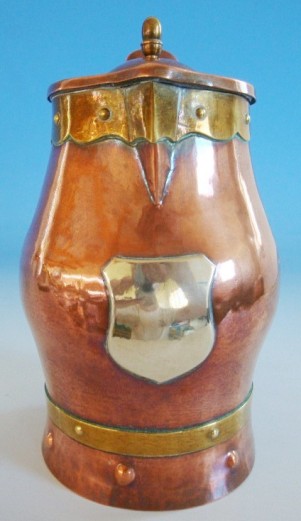
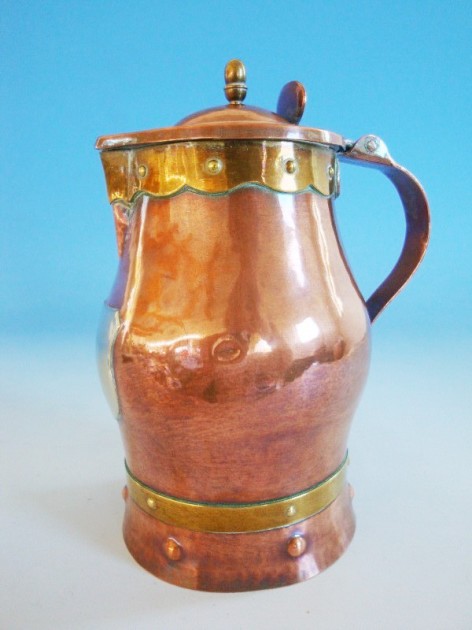
So I think I learned my lesson I saw this one and while nowhere near as old as the older relief one above, I just really liked it’s looks. especially the added brass; which is the primary reason one should have to buy any of this stuff! C.1850 with a really nice natural patina. It has a flat handle and a flat coin size thumblift.

While I have had the server to the right for some time now, I just picked up another just a bit taller and it has a different lid design and thumblift . They now flank my cupboard top wthat has other large (non- Bohemian) copper pieces on it.
[Ex-stephen Smith collection]
The .5 liter V&B Mettlach No. 1526 with hand painted Cost of Arms [family] is for size comparison.
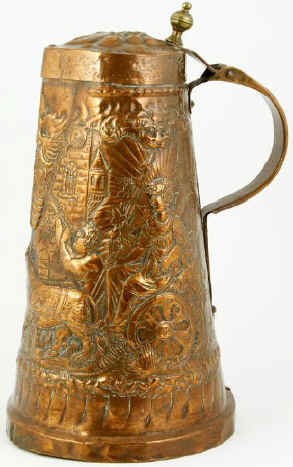
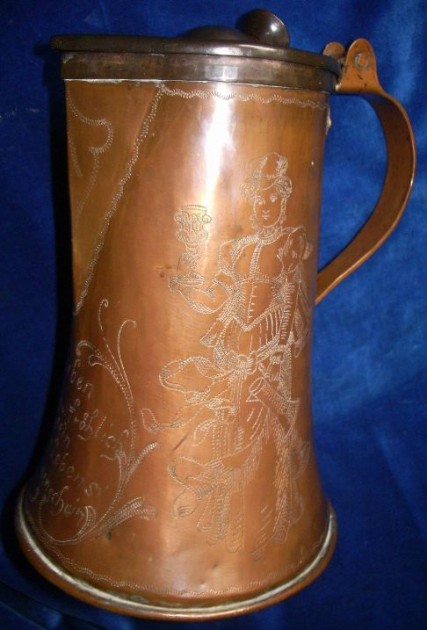

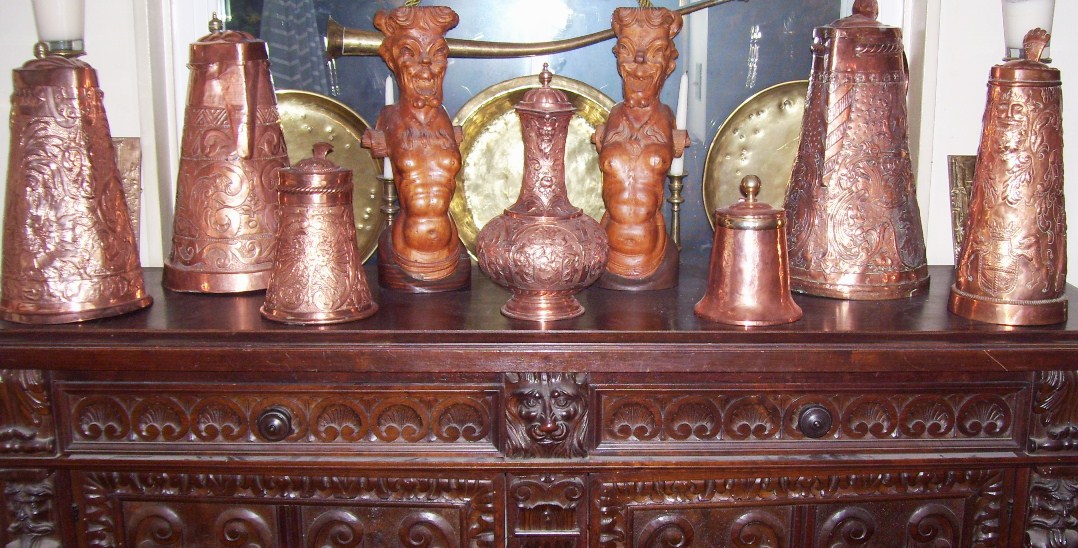
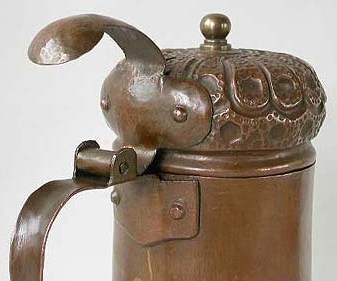
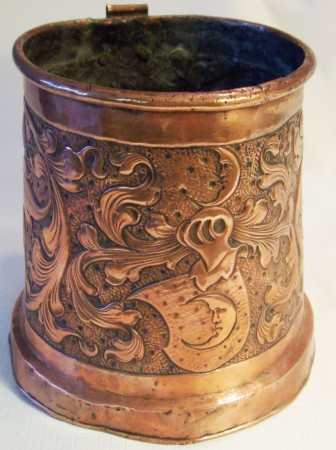
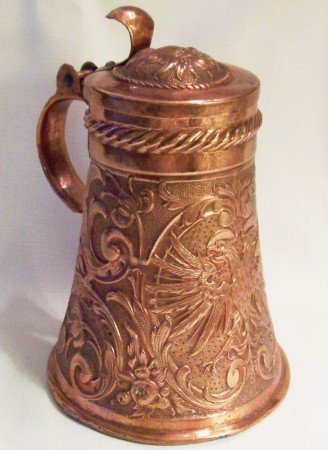
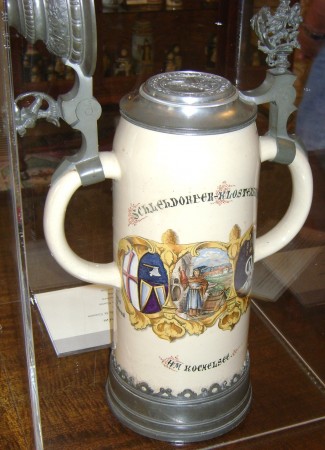
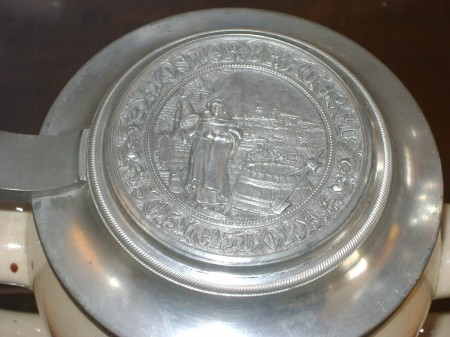
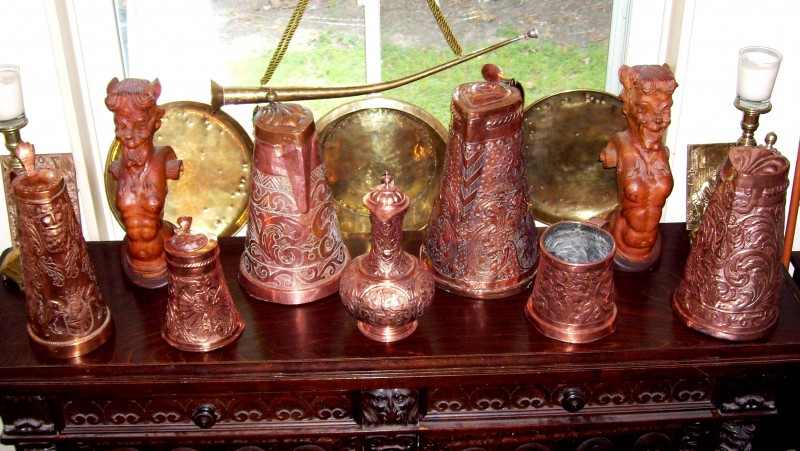
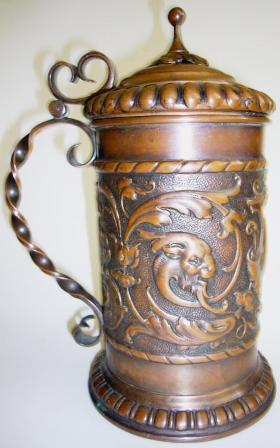
Leave a Reply